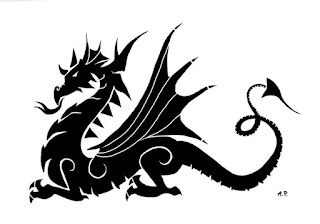Seraphina: The Conflict of Identity
Seraphina: The Conflict of Identity
I first read Seraphina as a senior in high school. I read it for one of our monthly book club meetings - no surprise there. And I immediately fell in love with it. Not only did Rachel Hartman (the author) create a whole new world, she gave it life. I completely immersed myself in the story, and forged a rare personal connection with Seraphina. I definitely recommend it! For those of you who haven't read it, Seraphina takes place in a world cohabited by dragons - saar - and humans. The two races barely tolerate each other. But before I delve into the much broader topic of saar vs. human, I'm going to take a look at each of them, respectively.
The saar are medieval-style dragons that can take human form - their saarantras. I suspect they mainly do this in order to study humans, maintain the peace treaty (signed approximately 40 years before the birth of our protagonist), and of course, your traditional spying. The saar are scholars, teachers and scientists. Their smaller relatives, the quigutl, work with metal, and can make small, intricate mechanisms. The saar value order and control, or ard, above all else, and consider human emotions to be disruptive of this controlled state in which they must remain. Therefore, any dragons who experience too much emotion are taken by the Censors. These Censors then excise the saar's brain, removing the emotions, typically memories. The humans view the saar as soulless creatures, inferior because of their soullessness, otherness, and emotional control. They live in Tanamoot, a region in the north composed mainly of mountains.
The humans in Seraphina are very similar to us. Their clothing style is more medieval, and their technology is not as advanced as that of the saar. They look down on the dragons for their emotional control, and for being something other than human. The dragons, however, view the humans as emotionally weak beings, inferior in intelligence and STEM (Science, Technology, Engineering, and Mathematics). The humans occupy most of the land, which is divided into Samsam, Porphyry, Ninys, and Goredd, the home country of our protagonist. These lands were previously the dragons' hunting grounds, producing a war that was ended 40 years before the beginning of our story by Comonot's Treaty. Much like our world, each human country has cultural differences, Porphyry standing out the most. Both races do share something in common other than mutual disdain. Ityasaari, or halfings, are taboo. Those who are found are violently murdered, along with their families.
Because of this, Seraphina, our protagonist, didn't even know she was an ityasaari until she was eleven. This was a measure of protection for Seraphina's sake, as well as that of her family. It could also have been a coping mechanism for her father. Not denial, perhaps - seeing his wife bleeding silver as she died is too strong to ignore. But maybe he harbored hope that Seraphina wouldn't manifest anything draconian. However, when her mind pearl (memories left behind by her mother) was activated by the true form of her uncle, her draconian side burst free. Seraphina grew scales around her waist and from one of her wrists to her elbow. Not only that, but the appearance of her Grotesques shows that ityasaari possess supernatural powers. Seraphina can communicate telepathically with the Grotesques, and can even see where they are.
I'm going to go back to when Seraphina first discovered she was half-saar. For eleven years, she believed she was human. I can't imagine her shock to discover otherwise, and in such a violent fashion, too. Her father was no help at all. In fact, his first interaction with Seraphina after her 'transformation' - for lack of a better word - became a large part of who she was from that day forward. While her father was hurt by his wife not telling him she was a dragon, I don't think it's fair to blame it on Seraphina. One of the first things he tells her is that she's ugly. As we discover later in the book, Seraphina had it a lot easier than other ityasaari. This does not, however, invalidate Seraphina's feelings, or that of her family.
Seraphina's relationship with her father hadn't been a good one since she was a child, but after her transformation, even more so. Being an ityasaari damages her relationship with her stepmother and siblings, as well as her opportunity to get a job - or even marry. She manages to get a job at the palace - which her father is unhappy about - but Seraphina is always keeping part of her hidden. She's forced to wear long sleeves so that her scales won't show. She keeps her distance from her colleagues. She's afraid of people getting too close, and so she can't be herself. She's lonely, forced into it by society.
The mutual discrimination between both races causes a lot of trouble. The dragons ignore the humans, making the humans hate the dragons even more. The humans, in turn are openly hostile. There is even a terrorist group called the Sons of St. Ogdo, named after the founder of the dracomachia, a very specific way to kill dragons. Each race demonizes the other as a way to better justify their hate and discrimination. An example is the belief that dragons are soulless. These conflicts even appear in the writing of history. While Seraphina is Princess Glisselda's music tutor, when she stumbles upon Glisselda making incorrect assumptions about the war she feels the need to correct her. What this incident demonstrates is that both sides of the war have different perspectives on what happened, and that hatred can cause you to twist reality into what you want to see. Not only that, but it calls into question whether the history we study is unbiased or if it was written by the winners.
Throughout the whole book, Seraphina struggles with her identity. She is always holding back, hiding a part of herself from the rest of the world. With her saar uncle, she learns about saar and is free to be herself, but with the rest of the world, she must be something she's not - completely human. She must mask a part of herself in favor of what others want to see. I think that this was one of the most relatable parts of the novel. Like Seraphina, I'm a blend of two worlds, but don't fully fit in either. At school, I hide one part of me so that the others see the half that blends in. I was made fun of for belonging in two worlds, to the point where I tried to hide it just like Seraphina. And, like Seraphina, I learned to see it as a strength.
Thank you for reading!
Disclaimer:
https://www.websitepolicies.com/policies/view/hECuXpJG
The intention of this blog is not to offend anyone. I provide my personal thoughts on the book, and have no intention of copying or distributing someone else's hard work - only recommend it and share my experience with it.
I do not own this book - all credit goes to Rachel Hartman. I do not own the images either.






Reading your blog made me want to read the book. Thank you for the insight.
ReplyDelete